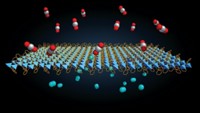Advertisement
Grab your lab coat. Let's get started
Welcome!
Welcome!
Create an account below to get 6 C&EN articles per month, receive newsletters and more - all free.
It seems this is your first time logging in online. Please enter the following information to continue.
As an ACS member you automatically get access to this site. All we need is few more details to create your reading experience.
Not you? Sign in with a different account.
Not you? Sign in with a different account.
ERROR 1
ERROR 1
ERROR 2
ERROR 2
ERROR 2
ERROR 2
ERROR 2
Password and Confirm password must match.
If you have an ACS member number, please enter it here so we can link this account to your membership. (optional)
ERROR 2
ACS values your privacy. By submitting your information, you are gaining access to C&EN and subscribing to our weekly newsletter. We use the information you provide to make your reading experience better, and we will never sell your data to third party members.
Materials
Metal-organic frameworks lickety-split
September 11, 2006
| A version of this story appeared in
Volume 84, Issue 37
Metal-organic frameworks (MOFs), with their high porosities and tailor-made molecular cavities, have been broadly pursued for a variety of applications, including hydrogen storage, catalysis, and nonlinear optical materials. One limitation has been the ability to prepare MOFs quickly--most syntheses require heating solutions a full day or longer. Richard I. Masel and Zheng Ni of the University of Illinois, Urbana-Champaign, have devised a rapid microwave-assisted MOF synthesis that allows the materials to be prepared in under a minute (J. Am. Chem. Soc., DOI: 10.1021/ja0635231). The researchers made three known MOFs by dissolving millimolar amounts of Zn(NO3)2·6H2O and 1,4-benzenedicarboxylate in N,N′-diethylformamide solvent, sealing the solution in a glass vial, then heating the vial in a microwave synthesizer. Micrometer-sized cubic crystals of the zinc-based MOFs formed in as little as 25 seconds and were recovered by centrifugation and rinsing. Smaller cubic particles with smoothed edges were obtained by lowering the concentration of the solution.



Join the conversation
Contact the reporter
Submit a Letter to the Editor for publication
Engage with us on Twitter